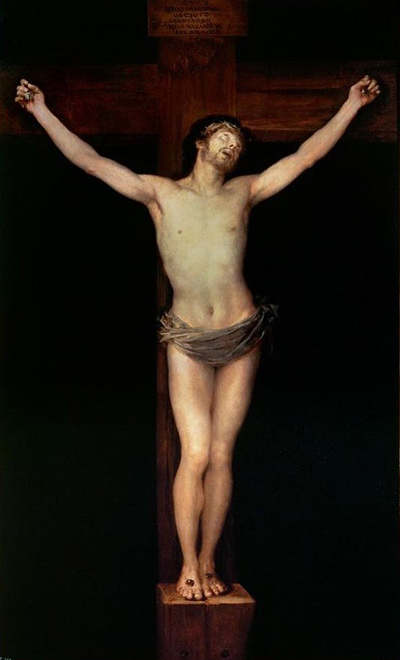Christ Crucified (also known as Crucifixion or Christ on the Cross) was painted in 1780 by Francisco de Goya.
The painting itself is of the neoclassical style. Neoclassicism was a Western movement in the arts that took inspiration from 'classical' art and the culture of Ancient Greece and Rome. It was born in Rome in the mid 18th century.
The main Neoclassical movement coincided with the 18th century Age of Enlightenment and continued on into the early 19th century where it competed with Romanticism. European Neoclassicism, however, began in 1760 in opposition to the popular Baroque and Rococo styles.
Goya is mostly known for his bloody and dramatic scenes that do not hide away from plain truth. Christ Crucified diminishes drama and the presence of blood, however, to focus on the painting's soft modelling. The beauty of his body has been emphasised instead of the use of gore. The expression upon Christ's face as he gazes up into the heavens is almost of ecstasy as he speaks "My God, why have you forsaken me?" But this is made subtle.
Goya's Christ Crucified was highly praised by the academy and he was favoured and praised during his era. His work lost popularity when associated with the Romanticism movement (1800 - 1850) and was thought of as having a lack of faith due to his satirical approach to his work.
The reason for the lack of blood and dramatic scenes is that he used Christ Crucified as a submission along with his application to the Royal Academy of Fine Arts of San Fernando in 1780. He wanted to make sure that his academic future was successful and not ruined by his characteristic bloody imagery.
Goya used a combination of the classical model with his knowledge of anatomy to create a new realism for a subject that has been painted for centuries. He displayed his knowledge of the body in the painting with the hopes of impressing the academy.
Goya was born in 1746 in Spain. His paintings usually reflected historical upheavals and he was best known for his scenes of violence. Goya had a bold technique and often his work had a haunting satire to it. He is often referred to as 'the first of the moderns'. Goya's uncompromising portrayal of the times marks the beginning of 19th century realism.
An example of Goya's other works include: Saturn Devouring His Sons, A Butcher's Counter and Witches Sabbath.
Goya's resistance on using a bloody, powerful scene to display such a gory and emotional event such as Christ's Crucifixion displays his eager intent to further his own career. Compared to paintings with a cruel violence in them, such as Saturn Devouring His Sons which depicts a bare grown man eating a decapitated bare child, there is less passion and characteristic to his work with this piece.
Though contemporaries favoured this artwork, the painting and his work in general seemed to lack religious symbolism, faith and hope within the art.
Regardless, Christ Crucified is an example of an artist being able to detach from his traditional style in order to create something completely different with the same skill for a different purpose.




